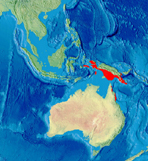| It is also called Double-wattled Cassowary. |
كسوري |
Class: Aves
Order: Struthioniformes
Family: Casuariidae
Species:Casuarius casuarius
It is also called Double-wattled Cassowary
Distribution:
Southern Cassowary is distributed in tropical rainforests of Aru and Seram Islands of Indonesia, New Guinea and northeastern Australia. |

|
Habitat:
It is a solitary and sedentary inhabitant of rainforest, occasionally using adjacent savanna forests, mangroves and fruit plantations.
Description:
Southern Cassowary also known as Double-wattled Cassowary is a large flightless black bird with hard and stiff plumage, a brown casque, blue face and neck, red nape and two red wattles hanging down its throat. The three-toed feet are thick and powerful, equipped with a lethal dagger-like claw on the inner toe. The female is dominant and larger with a longer casque and brighter-colored bare parts. The immature bird has plain brown plumage.
It is the largest member of the Cassowary family and is the second heaviest bird on earth, at a maximum size estimated at 85 kg (187 lb) and 190 cm (74 in). Normally this species ranges from 127 to 170 cm (50-67 in), with females averaging 58 kg (128 lb) and males averaging 33 kg (73 lb).
Lifespan:
It can reach up to 30 years.
Diet:
It forages on the forest floor for fallen fruit. They also eat insects, small vertebrates, and fungi.
Behavior:
Southern Cassowary is a solitary bird, that pairs only in breeding season,
Reproduction:
Breeding season takes place in late winter or spring. The male builds a nest on the ground; a mattress of herbaceous plant material 5–10 cm (2–4 in) thick and up to 100 cm (40 in) wide. This is thick enough to let moisture drain away from the eggs. It is situated in a sheltered area among tall grass or similar cover. He also incubates the eggs (for 47 to 61 days) and raises the chicks.
A clutch of 3 or 4 eggs are laid measuring 138 mm x 95 mm. They have a granulated surface and are initially bright pea-green in color though fading with age.
At about 3 years of age, southern cassowaries are able to reproduce.
Conservation status:
IUCN Red List: Vulnerable.
References:http://www.iucnredlist.org/apps/redlist/details/141088/0 http://en.wikipedia.org/wiki/Casuarius_casuarius